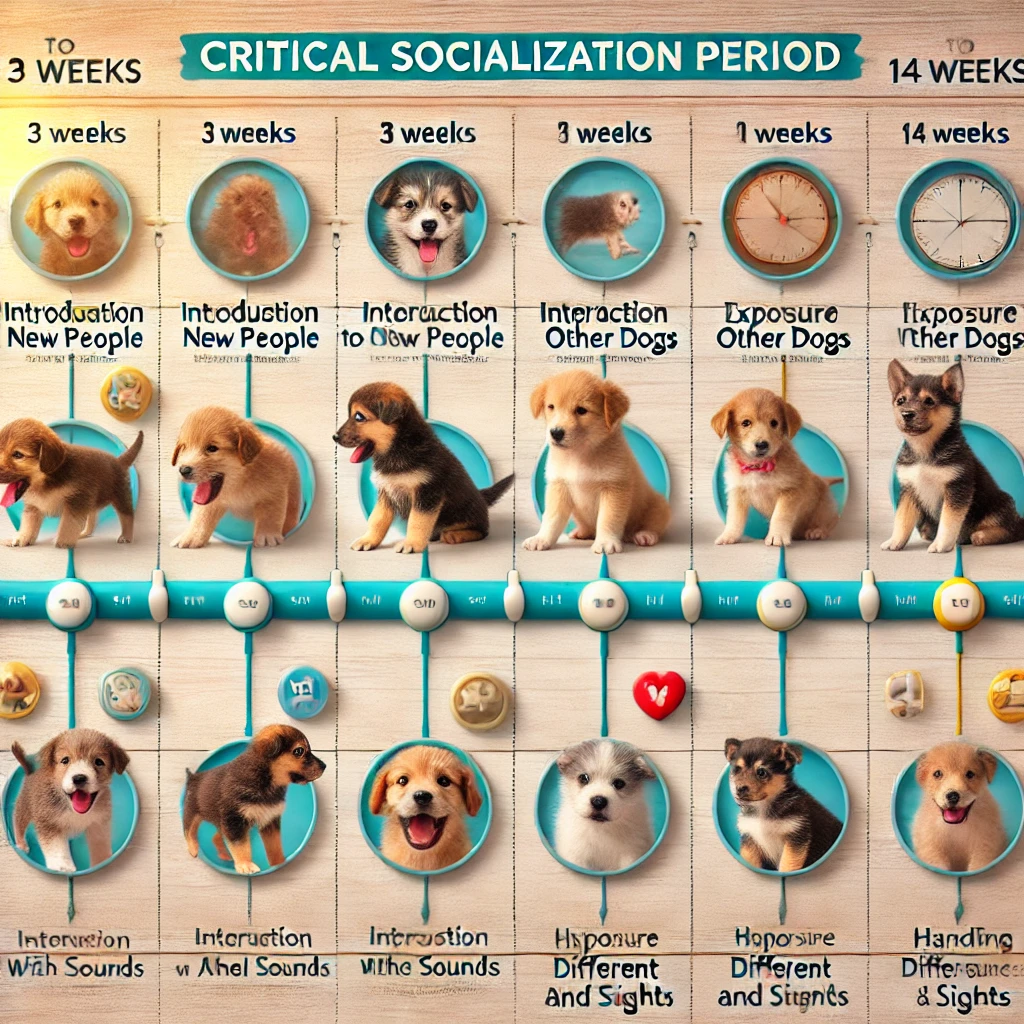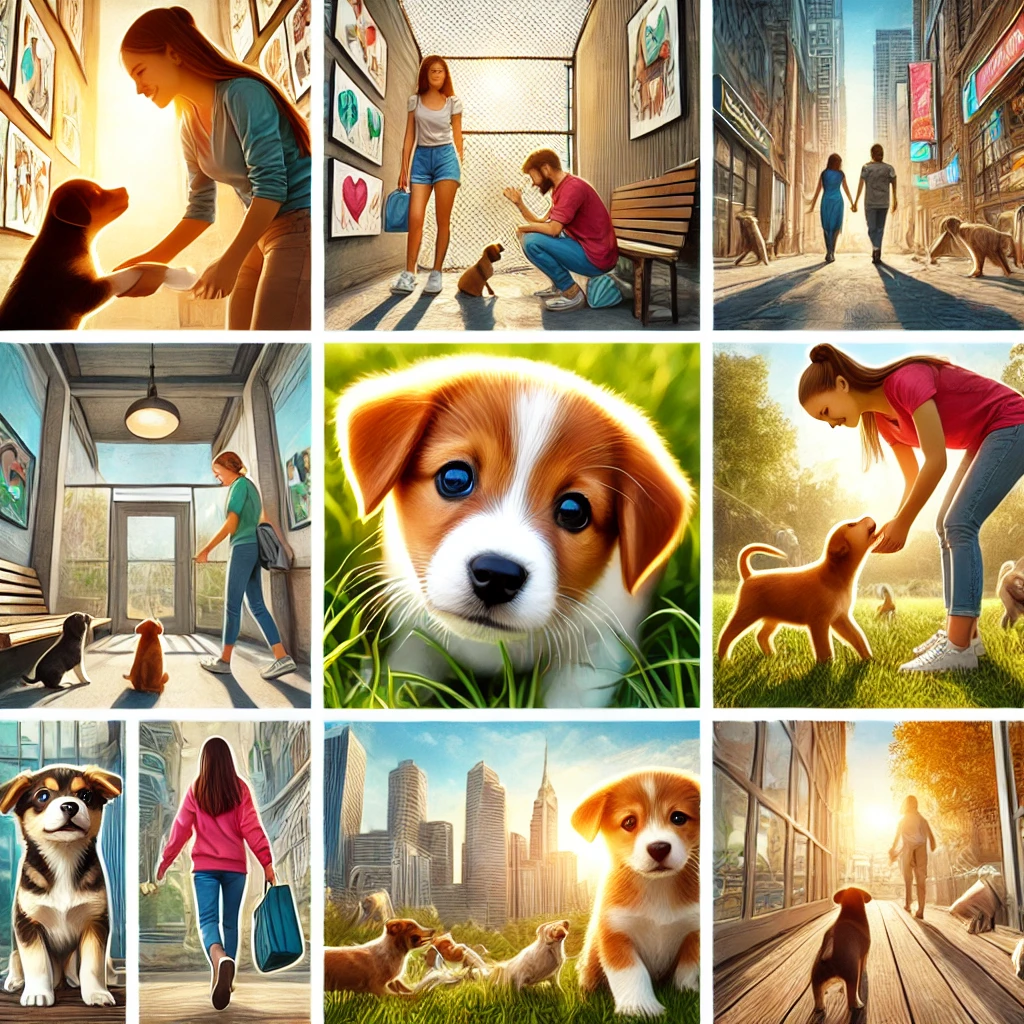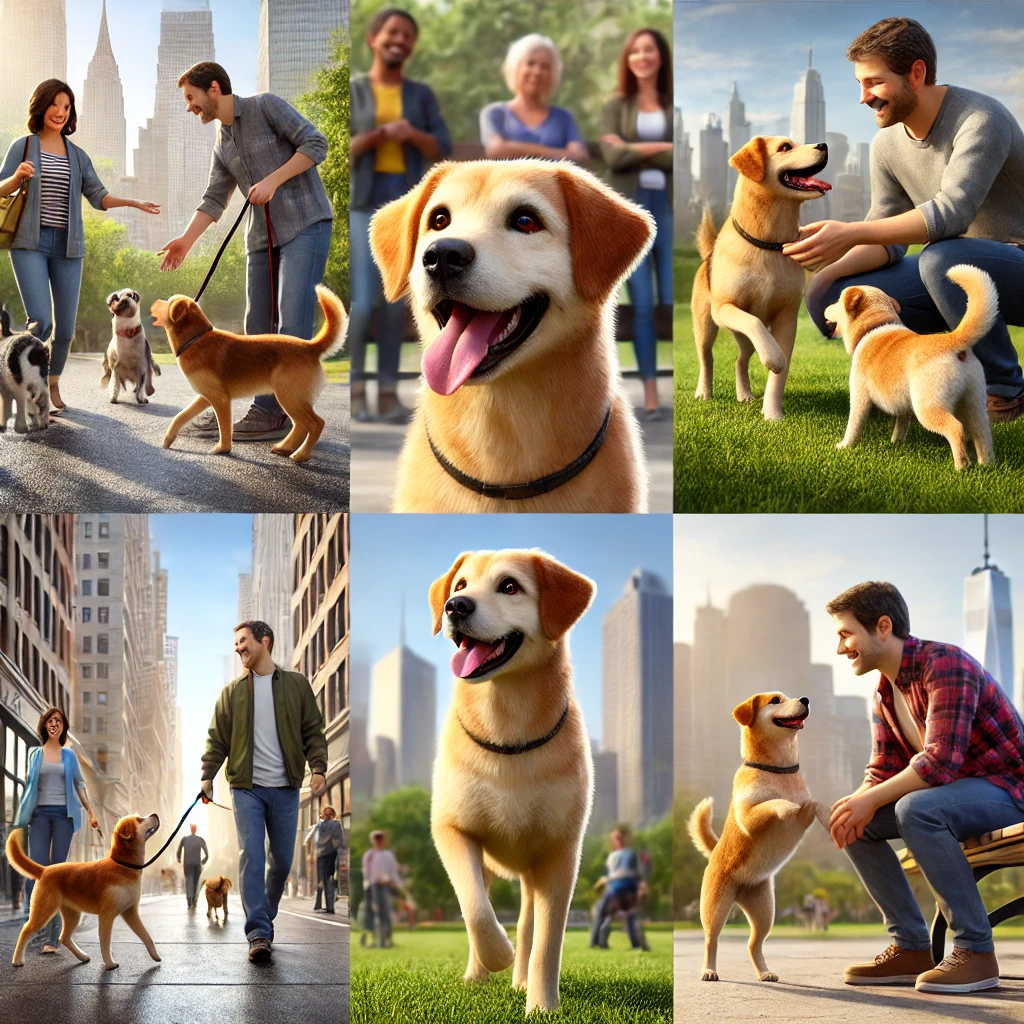Introduction
Bringing a new puppy into your home is an exciting adventure filled with wagging tails, wet kisses, and countless photo opportunities. However, along with the joy comes the responsibility of raising a well-adjusted, confident adult dog. One of the most crucial aspects of this journey is puppy socialization.
Proper socialization involves exposing your puppy to a wide variety of people, animals, environments, and experiences in a positive, controlled manner. This process is fundamental in shaping your puppy’s behavior, confidence, and overall temperament as they grow into adulthood. A well-socialized puppy is more likely to become a friendly, adaptable, and well-behaved adult dog, making life more enjoyable for both you and your furry companion.
This comprehensive guide will walk you through the ins and outs of puppy socialization, providing you with essential tips, strategies, and insights to help you navigate this critical period in your puppy’s development. Whether you’re a first-time puppy owner or an experienced dog parent, this guide will equip you with the knowledge and tools to set your puppy up for a lifetime of positive social interactions.
![[IMAGE: A happy puppy interacting confidently with people and other dogs in a park setting, illustrating the goal of successful socialization]](https://quitepuppy.com/wp-content/uploads/2024/08/92d345dd-20d9-4c02-9208-35374682707e.webp)
What is Puppy Socialization?
Puppy socialization is the process of introducing your young dog to a wide range of experiences, including new people, animals, environments, sounds, and stimuli. The primary goal of socialization is to help your puppy develop into a well-adjusted adult dog that is comfortable and confident in various situations.
The Science Behind Socialization
Socialization is rooted in developmental psychology and neuroscience. During the critical socialization period, a puppy’s brain is highly plastic, meaning it’s especially receptive to new experiences. Positive experiences during this time help form neural pathways that contribute to a dog’s ability to cope with new situations later in life.
Benefits of Proper Socialization
- Reduced fear and anxiety: Well-socialized puppies are less likely to develop fear-based behaviors in unfamiliar situations.
- Better adaptability: Socialized dogs can more easily adapt to new environments and experiences.
- Improved behavior: Proper socialization often leads to fewer behavioral problems in adulthood.
- Enhanced communication: Socialized dogs typically have better communication skills with both humans and other animals.
- Increased safety: A well-socialized dog is generally safer around people and other animals, reducing the risk of fear-based aggression.
Differences Between Socialization and Training
While socialization and training are both crucial for your puppy’s development, they serve different purposes:
- Socialization focuses on exposing your puppy to various experiences to build confidence and adaptability.
- Training involves teaching specific commands, behaviors, and skills.
Both are important and often overlap, but socialization should begin even before formal training starts.
The Critical Socialization Period
Understanding the Sensitive Period
The critical socialization period for puppies typically occurs between 3 and 14 weeks of age. This window is often referred to as the “sensitive period” because puppies are most receptive to new experiences during this time.
Why Timing is Crucial
During the sensitive period, puppies are naturally curious and less likely to be fearful of new experiences. Their brains are rapidly developing, forming neural connections that will shape their future behaviors and responses.
What Happens After the Critical Period
While socialization should continue throughout a dog’s life, it becomes more challenging after the critical period. Puppies may become more cautious or fearful of new experiences, making the socialization process slower and potentially more stressful.

When to Start Socializing Your Puppy
The Ideal Age Range
The ideal time to start socializing your puppy is between 3 and 14 weeks of age. However, this doesn’t mean you should wait until your puppy is 3 weeks old to begin. If you’ve acquired your puppy from a responsible breeder, they should have already started the socialization process.
Balancing Socialization and Vaccination
One common concern is balancing socialization with the need to protect puppies from diseases before they’re fully vaccinated. While it’s important to be cautious, the American Veterinary Society of Animal Behavior (AVSAB) states that the risk of behavioral issues due to lack of socialization outweighs the risk of infectious diseases in puppies.
Here are some guidelines for safe early socialization:
- Start at home by exposing your puppy to various household sounds, textures, and experiences.
- Carry your puppy in public places to observe different environments safely.
- Arrange controlled meetings with vaccinated, friendly dogs.
- Attend puppy classes where all puppies are required to have age-appropriate vaccinations.
Always consult with your veterinarian to create a socialization plan that is safe and appropriate for your puppy’s individual health status.
What to Do If You Missed the Early Window
If you’ve adopted an older puppy or missed the critical socialization period, don’t despair. While early socialization is ideal, it’s never too late to improve your dog’s social skills. Here are some tips for socializing older puppies or adult dogs:
- Take it slow: Introduce new experiences gradually and at your dog’s pace.
- Use positive reinforcement: Associate new experiences with treats, praise, and play.
- Be patient: Older dogs may take longer to adjust to new situations.
- Consult a professional: A certified dog trainer or behaviorist can provide tailored advice for your dog’s needs.
Steps to Effective Puppy Socialization
Creating a Socialization Checklist
Develop a comprehensive socialization checklist to ensure you’re exposing your puppy to a wide range of experiences. Your checklist should include:
- People: Different ages, genders, ethnicities, and appearances (e.g., people with beards, hats, or glasses)
- Animals: Other dogs, cats, and common pets or livestock
- Environments: Urban areas, parks, beaches, forests
- Sounds: Traffic, household appliances, fireworks (recordings), thunder
- Objects: Umbrellas, bicycles, wheelchairs, strollers
- Surfaces: Grass, concrete, wood floors, metal grates
Gradual Introduction to New Environments
Start with calm, controlled environments and gradually progress to more stimulating ones. For example:
- Begin in your home and backyard
- Move to quiet streets in your neighborhood
- Progress to local parks during less busy times
- Advance to busier areas like pet stores or outdoor markets
Meeting Different People
Expose your puppy to a variety of people in a controlled, positive manner:
- Family members and friends: Start with people your puppy knows and trusts.
- Children: Supervise all interactions and teach children how to properly interact with puppies.
- People in uniforms: Introduce your puppy to people in various uniforms (e.g., mail carriers, police officers) to prevent fear of uniforms later in life.
- People with different physical characteristics: Expose your puppy to people of different ages, sizes, and those using mobility aids.
Positive Interactions with Other Dogs and Animals
Safe interactions with other animals are crucial for developing good social skills:
- Arrange puppy playdates: Set up meetings with friends’ vaccinated, friendly dogs.
- Attend puppy socialization classes: These provide a controlled environment for puppy-to-puppy interaction.
- Observe from a distance: Allow your puppy to watch other dogs play in a park from a safe distance.
- Introduce other pets: If you have other pets, gradually introduce them to your puppy under close supervision.
Exposure to Various Sounds and Sights
Help your puppy become accustomed to different stimuli:
- Household sounds: Vacuum cleaners, doorbells, TV noises
- Outdoor sounds: Traffic, construction noise, sirens
- Weather-related sounds: Rain, wind, thunder (you can use recordings for these)
- Visual stimuli: Moving objects, flashing lights, people in costumes

Socialization Do’s and Don’ts
Do’s
- Start early: Begin socialization as soon as it’s safe to do so.
- Keep experiences positive: Use treats, praise, and play to create positive associations.
- Go at your puppy’s pace: Watch for signs of stress and adjust accordingly.
- Be consistent: Make socialization a regular part of your puppy’s routine.
- Involve the whole family: Ensure everyone in the household participates in the socialization process.
Don’ts
- Don’t force interactions: If your puppy seems scared, don’t push them into situations they’re not ready for.
- Avoid overwhelming your puppy: Keep socialization sessions short and fun.
- Don’t expose your puppy to unsafe situations: Ensure all interactions are controlled and safe.
- Don’t skip veterinary advice: Always consult with your vet about safe socialization practices.
- Don’t neglect ongoing socialization: Continue socializing your dog throughout their life.
Socialization Tips for Different Settings
At Home
- Introduce new objects: Expose your puppy to different household items, textures, and surfaces.
- Practice handling: Get your puppy used to being touched all over their body, including paws, ears, and mouth.
- Use sound recordings: Play recordings of various sounds (e.g., fireworks, thunderstorms) at a low volume, gradually increasing it over time.
Outdoors
- Go on “smell walks”: Allow your puppy to explore and sniff different environments.
- Visit various locations: Take your puppy to parks, pet-friendly stores, and different neighborhoods.
- Experience different weather: Let your puppy experience rain, snow, or wind (as appropriate for your climate).
Socialization Classes and Puppy Playdates
- Choose reputable classes: Look for classes run by certified trainers who emphasize positive reinforcement.
- Ensure safety: Make sure all puppies in the class are of similar age and size.
- Monitor interactions: Supervise playtime closely and intervene if play becomes too rough.
Dealing with Socialization Challenges
How to Handle Fearful or Shy Puppies
- Identify triggers: Observe what specifically causes fear in your puppy.
- Use desensitization: Gradually expose your puppy to the fear trigger from a distance where they’re comfortable.
- Counter-conditioning: Pair the fear trigger with positive experiences (treats, play).
- Be patient: Progress may be slow, but consistency is key.
Addressing Overstimulation
- Recognize signs: Watch for signs of overstimulation like excessive mouthing, jumping, or inability to settle.
- Provide breaks: Give your puppy quiet time to relax and process new experiences.
- Use calming techniques: Teach your puppy a “settle” command or use puzzle toys to help them calm down.
When to Seek Professional Help
Consider consulting a professional dog trainer or behaviorist if:
- Your puppy shows signs of extreme fear or aggression
- Socialization efforts aren’t progressing despite your best efforts
- You’re unsure how to handle specific behavioral issues
Common Socialization Myths
Myth: Socialization Only Means Meeting Other Dogs
Reality: While dog-to-dog socialization is important, it’s equally crucial to expose your puppy to various people, environments, and experiences.
Myth: Puppies Will Naturally Become Social
Reality: While some puppies may be naturally outgoing, proper socialization is a learned behavior that requires effort and guidance from the owner.
Myth: Socialization Isn’t Necessary for Small Breeds
Reality: All dogs, regardless of size, benefit from proper socialization. In fact, small breeds may need extra socialization to prevent fear-based behaviors.
Myth: Once the Critical Period is Over, Socialization is No Longer Important
Reality: While the critical period is crucial, socialization should continue throughout a dog’s life to maintain good social skills and adaptability.
Long-Term Socialization Strategies
Continued Exposure to New Environments and Experiences
- Regular outings: Continue taking your dog to new places and exposing them to new experiences.
- Varied walking routes: Change up your walking routine to expose your dog to different sights and smells.
- Travel experiences: If possible, include your dog in family trips or vacations.
Reinforcing Positive Social Behaviors
- Reward calmness: Praise and treat your dog for remaining calm in new or challenging situations.
- Practice obedience in various settings: Reinforce training commands in different environments to build confidence.
- Encourage positive interactions: Continue to facilitate positive experiences with people and other dogs.
Monitoring Socialization Progress Over Time
- Keep a journal: Document your dog’s reactions to different situations and track progress over time.
- Regular check-ins: Periodically assess your dog’s comfort level in various social situations.
- Be proactive: Address any emerging issues promptly to prevent them from becoming ingrained behaviors.
Real-Life Examples and Success Stories
Case Study: Max the Anxious Puppy
Max, a 4-month-old Labrador Retriever, was extremely fearful of new people and environments. His owners implemented a gradual socialization plan, starting with low-stress exposures at home and slowly progressing to more challenging situations. After three months of consistent effort, Max became significantly more confident, eagerly greeting new people and exploring new environments with enthusiasm.
Testimonial from a Dog Trainer
“I’ve seen countless puppies transform through proper socialization. One standout case was a shy Chihuahua named Bella. Her owners were diligent about positive exposure to various people, dogs, and environments. By the time Bella was a year old, she was a social butterfly, confidently navigating busy city streets and making friends at the dog park. It’s a testament to the power of early, consistent socialization.” – Sarah Johnson, Certified Professional Dog Trainer
FAQs About Puppy Socialization
Q: What happens if my puppy isn’t socialized?
A: Lack of socialization can lead to fear, anxiety, and potentially aggression in adult dogs. Under-socialized dogs may struggle with new experiences and have difficulty adapting to changes in their environment.
Q: How long does the socialization process take?
A: The critical socialization period lasts until about 14-16 weeks of age, but socialization should continue throughout a dog’s life. The initial intensive socialization period typically lasts 2-3 months.
Q: Can older dogs be socialized?
A: Yes, older dogs can be socialized, although it may take more time and patience. The process is similar to puppy socialization but should progress more slowly and may require professional guidance.
Q: How do I socialize my puppy during the COVID-19 pandemic?
A: Focus on at-home socialization experiences, use virtual sounds and videos, and take your puppy on car rides to observe the world. When possible, arrange controlled meetings with fully vaccinated people and dogs.
Q: Is it possible to over-socialize a puppy?
A: While it’s rare to truly over-socialize a puppy, it’s possible to overwhelm them with too many experiences too quickly. Always watch for signs of stress and give your puppy plenty of rest between socialization sessions.
Conclusion
Puppy socialization is a crucial investment in your dog’s future. By exposing your puppy to a wide range of positive experiences during their critical developmental period, you’re laying the foundation for a confident, well-adjusted adult dog. Remember that socialization is an ongoing process that extends beyond puppyhood – continue to provide your dog with new, positive experiences throughout their life.
While the task of socialization may seem daunting, the rewards are immeasurable. A well-socialized dog is a joy to live with and can participate fully in family activities. They’re more likely to be comfortable in various situations, from vet visits to family gatherings, making life easier and more enjoyable for both you and your furry companion.
As you embark on this socialization journey with your puppy, stay patient, consistent, and always prioritize positive experiences. Celebrate small victories along the way, and don’t hesitate to seek professional help if you encounter challenges. With dedication and the right approach, you’ll be setting your puppy up for a lifetime of happiness and success.
Remember these key points as you socialize your puppy:
- Start early, ideally between 3-14 weeks of age
- Create positive associations with new experiences
- Expose your puppy to a variety of people, animals, environments, and stimuli
- Go at your puppy’s pace and never force interactions
- Continue socialization efforts throughout your dog’s life
By following these guidelines and putting in the effort during those crucial early weeks, you’re giving your puppy the best possible start in life. The bond you’ll form and the ease of living with a well-socialized dog will be your reward for years to come.

